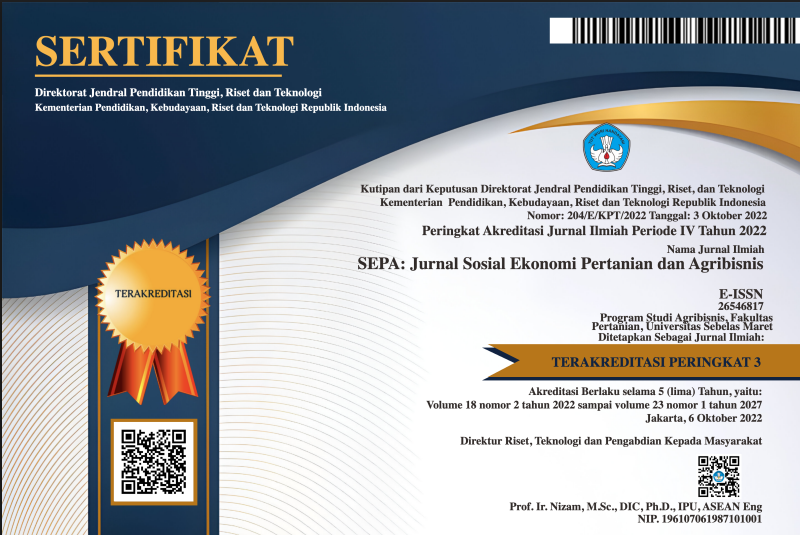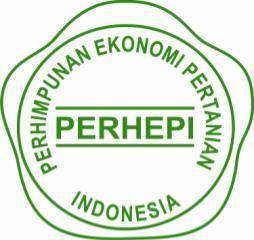KETAHANAN PANGAN RUMAH TANGGA BERDASARKAN PENDAPATAN PETANI JAGUNG MANIS DI DESA BULUPOUNTU JAYA KECAMATAN SIGI BIROMARU
Abstract
Food is a basic need for humans to survive, and therefore adequate food for everyone is a basic right that deserves to be fulfilled. One of the important indicators affecting the food security status of farmer households is income. This study aims to determine the amount of income obtained from maize farming and the value of household food security of maize farmers in the Bulupountu Jaya Village, Sigi Biromaru District, Sigi Regency. The research was conducted from July to September 2020. The analytical method used is a descriptive based on the farm household income, staple food needs, and local staple food prices. The results showed that the income received by maize farmers for one planting season was IDR 6,384,691.85/farmer or IDR 5,010,159.76/ha with revenue of IDR 10,182,692.31/ farmer or IDR 13,441,153.85/ha. Meanwhile, the total production cost incurred is IDR 3,798,000.46/farmer or IDR 5,010,159.76/ha. The farm household income from outside maize farming comes from livestock businesses amounting to IDR 5,007,692.31 and as a laborer an amount of IDR 5,215,384.61, with a total side income of IDR 10,223,076.92. Farm household food security shows a value greater than 1 (Z>1), amounting to IDR 9,250,776.92, which means that maize farmer households with a side business will have a food security condition in a year and have an excess of IDR.9,250,776.92, to buy necessities other than staple food (rice).
Keywords
Full Text:
PDFReferences
Agusta, I. (2014). Teknik pengumpulan dan analisis data kualitatif. Jurnal Studi Komunikasi dan Media, 4(2), 1–8.
Arimbawa, P. D. & Widanta, A. B. P. (2017). Pengaruh luas lahan teknologi dan pelatihan terhadap pendapatan petani padi dengan produktivitas sebagai variabel intervening di Kecamatan Mengwi. Arimbawa Dika Putu, 6(8), 1601–1627.
Atem & Niko, N. (2020). Persoalan kerawanan pangan pada masyarakat miskin di wilayah perbatasan Entikong (Indonesia-Malaysia) Kalimantan Barat. Jurnal Surya Masyarakat, 2(2), 94–104.
Burchi, F. & Muro, P. D. (2012). A Human Development and Capability Approach to Food Security: Conceptual Framework and Informational Basis. Rome: United Nations Development Programme.
Fauzi, M., Kastaman, R. & Pujianto, T. (2019). Pemetaan ketahanan pangan pada Badan Koordinasi Wilayah I Jawa Barat. Jurnal Industri Pertanian, 01(01), 1–10.
Gundersen, C., Kreider, B., & Pepper, J. (2011). The economics of food insecurity in the United States. Applied Economic Perspectives and Policy, 33(3), 281–303. https://doi.org/10.1093/aepp/ppr022.
Gustafson, D. J. (2013). Rising food costs & global food security: Key issues & relevance for India. Indian Journal of Medical Research, 138(3), 398–410.
Gustianan, C. & Irwanto, I. (2017). Pengaruh biaya produksi, pengalaman, dan keterampilan terhadap pendapatan usahatani kakao (Theobroma cacao) di Kecamatan Karang Baru Kabupaten Aceh Tamiang. Jurnal Penelitian Agrisamudra, 4(2), 67–76. https://doi. org/10.33059/jpas.v4i2.286.
Julianto, D. & Utari, P. A. (2019). Analisa pengaruh tingkat pendidikan terhadap pendapatan individu di Sumatera Barat. Ikra-Ith Ekonomika, 2(2), 122–131.
Jumiyati, S. (2019a). Increasing income of cocoa farming through the role of agricultural extension and strengthening institutional capacity of farmers. International Journal of Agriculture, Environment and Bioresearch, 4(6), 110–121.
Jumiyati, S. (2019b). Poverty level of farmers based on total income and feasibility of rice farming. World Journal of Advanced Research and Reviews, 4(20), 082–089.
Jumiyati, S., Arsyad, M., Rajindra, R., Pulubuhu, D. A. T. & Hadid, A. (2018). Cocoa based agroforestry: An economic perspective in resource scarcity conflict era. IOP Conference Series: Earth and Environmental Science, 575, 012009, 1–7. https://doi. org/10.1088/1755-1315/157/1/012009.
Jumiyati, S., Rajindra, R., Arsyad, M., Pulubuhu, D. A. T. & Hadid, A. (2019). Strategy of Agrarian-Forestry Crisis Management: Participation Collaboration and Conflict. IOP Conference Series: Earth and Environmental Science, 235, 012041, 1–8. https://doi.org/10.1088/ 17551315/235/1/012041.
Lubisn, B. & Mulianingsih, S. (2019). Keterkaitan bonus demografi dengan teori generasi. Jurnal Registratie, 1(1), 21–36.
Mardani. T., Nur., M. & Satriawan, H. (2017). Analisis usaha tani tanaman pangan jagung manis di Kecamatan Juli Kabupaten Bireuen. S. Pertanian, 1(3), 203–212.
Nugraha, S. I. & Alamsyah, A. (2019). Factors affecting income level of rubber farmers in Village of Sako Suban Districts of Batang Hari Leko, South Sumatra. Jurnal Ilmu Pertanian Indonesia, 24(2), 93–100. https://doi.org/10.18343/jipi. 24.2.93.
Pangaribowo, E. H., Gerber, N. & Torero, M. A. (2013). Food and nutrition security indicators: A Review. SSRN Electronic Journal. 1–50. https://doi.org/10.2139 /ssrn.2237992.
Pawlak, K. & Kolodzjekczak, M. (2020). The role of agriculture in ensuring food security in developing countries: Considerations in the context of the problem of sustainable food production. Sustainability (Switzerland), 12(13), 5488, 1–20. https://doi.org/3390//su 12135488.
Prabowo, R. (2010). Kebijakan pemerintah dalam mewujudkan ketahanan pangan di Indonesia. Mediagro, 6(2), 62–73.
Pratama, P. (2014). Analisis pendapatan dan kelayakan usahatani padi sawah di Desa Sidondo 1 Kecamatan Sigi Biromaru Kabupaten Sigi. E-Jurnal Agrotekbis, 2(1), 107–113.
Saliem, H. P. & Ariani, M. (2016). Ketahanan pangan, konsep, pengukuran dan strategi. Forum Penelitian Agro Ekonomi, 20(1), 12–24. https://doi.org/10.21082/fae. v20n1.2002.12–24.
Saputro, W. A. & Sariningsih, W. (2020). Kontribusi pendapatan usahatani kakao terhadap pendapatan rumah tangga petani di Taman Teknologi Pertanian Nglanggeran Kecamatan Pathuk Kabupaten Gunungkidul. SEPA: Jurnal Sosial Ekonomi Pertanian dan Agribisnis, 16(2), 208–217. https://doi. org/10.20961/sepa.v16i2.35825.
Suharyanto, H. (2011). Ketahanan pangan. Jurnal Sosial Humaniora, 4(2), 186–194. https://doi.org/10.12962/j24433527.v4i2.633.
Suryana, A. (2014). Menuju ketahanan pangan Indonesia berkelanjutan 2025: Tantangan dan penanganannya. Forum Penelitian Agro Ekonomi, 32(2), 123–135. https://doi.org/10.21082/fae.v32n2.2014.123-135.
Swastika, D. K. S. (2011). Membangun kemandirian dan kedaulatan pangan untuk mengentaskan petani dari kemiskinan. Jurnal Pengembangan Inovasi Pertanian, 4(2), 103–117.
Syahyuti, N., Sunarsih, N., Wahyuni, S., Sejati, W. K. & Azis, M. (2016). Kedaulatan pangan sebagai basis untuk mewujudkan ketahanan pangan nasional. Forum Penelitian Agro Ekonomi, 33(2), 95–109. https://doi.org/10.21082/fae.v33n2.2015.95-109.
Wahyunto, W., Supriatna, W. & Agus, F. (2013). Land use change and recommendation for sustainable development of peatland for agriculture: Case study at Kubu Raya and Pontianak Districts, West Kalimantan. Indonesian Journal of Agricultural Science, 11(1), 32–40. https://doi.org/10.21082/ijas. v11n1.2010.p32-40.
Welang, F. R., Dumais, J. N. K. & Sendow, M. M. (2016). Analisis pendapatan usahatani padi sawah berdasarkan musim panen di Kelurahan Taratara Satu Kecamatan Tomohon Barat Kota Tomohon. Agri-Sosioekonomi, 12(2), 107–124. https://doi.org/10.35791/agrso sek.12.2a.2016.12725.
Zahra, K. & Zafar, T. (2015). Marginality as a root cause of urban poverty: A case study of Punjab. Pakistan Development Review, 54(4), 629–648. https://doi.org/ 10.30541/v54i4i-iipp.629-650.
DOI: https://doi.org/10.20961/sepa.v18i2.48965
Refbacks
- There are currently no refbacks.



.png)







.png)
3.png)





